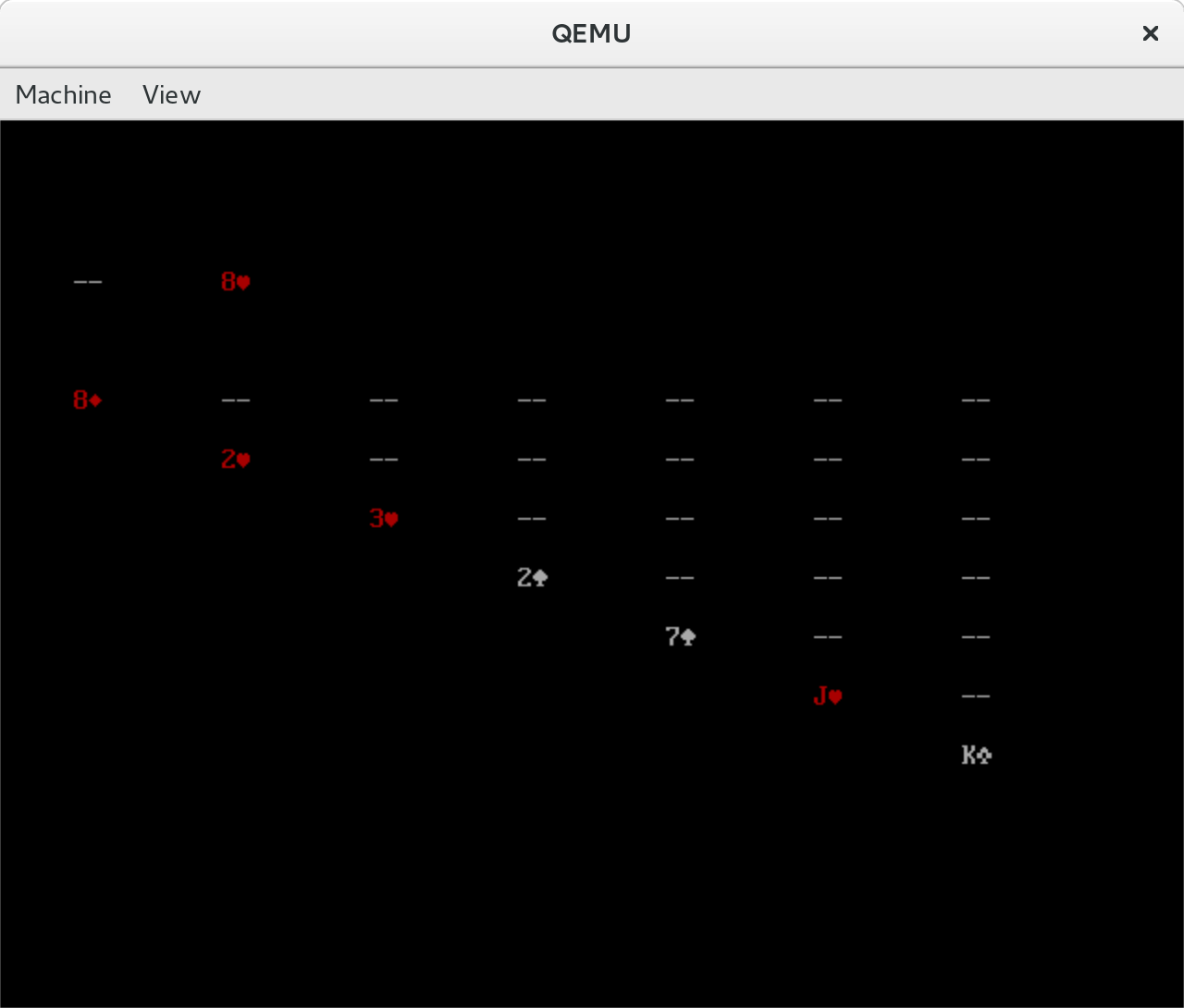masneyb / Boot2sol
Programming Languages
boot2sol
Solitaire. Written inside the bootloader.
Overview
As part of Move Inc.'s Startup Hackathon, 2016, our team decided to write solitaire within the first stage bootloader. The goal is to boot an x86 PC with a traditional BIOS (no UEFI) into an interactive game of solitaire without an operating system. Introduction video:
Team Members
- Brian Masney - masneyb
- Brian Sizemore - bpsizemore
- Ricky Hussmann - rhussmann
- Will Austin - dreae
Technical Requirements
- Must be written in 16-bit x86 assembly language
- Program code and data must fit on a single sector on disk
- 512 bytes total
- Last 2 bytes is the boot sector signature (AA55h)
- Only 510 bytes total available for our data and code
- System running in real mode; no memory production available
- Limited tooling available for debugging issues
- Requires detailed knowledge of x86 architecture
Development Toolchain
- Developed in Linux
- Brian M. and Will used Fedora natively
- Brian S. used Fedora under Virtualbox
- Ricky H. used Ubuntu under VMWare
- NASM used for assembly
- mkdosfs used to create the boot floppy
- QEMU for virtualizing the hardware
Design
There are thirteen piles in solitaire:
- The draw pile
- The discard pile
- A pile for each completed suit (four piles)
- Seven play piles
We included another pile, the space between the discard pile and the suit piles. This pile is never added to or drawn from, but its existence simplifies the implementation. So, boot2sol recognizes a total of 14 piles, zero indexed.
The cards in each pile are represented as a linked list. 14 bytes of data are reserved for the head of each pile in the list. The representation of each card uses one byte:
| Shown | Unused | Offset to next card |
|---|---|---|
| 1 bit | 1 bit | 6 bits |
The cards are stored in memory grouped by family. Inside each family, the cards
are ordered ace through king. This allows using the offset in memory to calculate
the card value and family.
Pseudocode: offset / 13 = family and offset mod 13 = card value (ace-king).
The end of the linked list in the next pointer is represented with the value 0x111111 (6 ones).
How to run the game
- Fedora Linux users should only need to run
sudo dnf install qemu-system-x86 nasmto fetch the necessary dependencies. - Debian-based systems should only need to run
sudo apt-get install qemu-system-x86 nasmto fetch the necessary dependencies. -
make runcompiles the program and launches it in a VM on your local machine using QEMU. - To run it on bare metal, run
maketo compile anddd if=boot.bin of=/dev/sdX bs=512 count=1, where sdX is the path to a thumb drive that you want to boot from. Beware: This will destroy any data you have on your thumb drive.
Keyboard commands
- The
dkey advances the draw pile. - The
mkey is used to move one or more cards from one pile to another. It takes three additional keyboard commands:- Source pile number (See table below)
- Source pile card index (from the top of the list). Allowed values: a-z, for the 1st through 26th card. The code won't advance past the end of the end of the pile so you can always use z to select the last card pile in the pile.
- Destination pile number (See table below)
The source and destination pile number for the move command is represented by the following table:
| a | b | d | e | f | g | |
|---|---|---|---|---|---|---|
| h | i | j | k | l | m | n |
For example: You can press mnzk to move the last card on pile n (bottom right) to the end of pile k.


